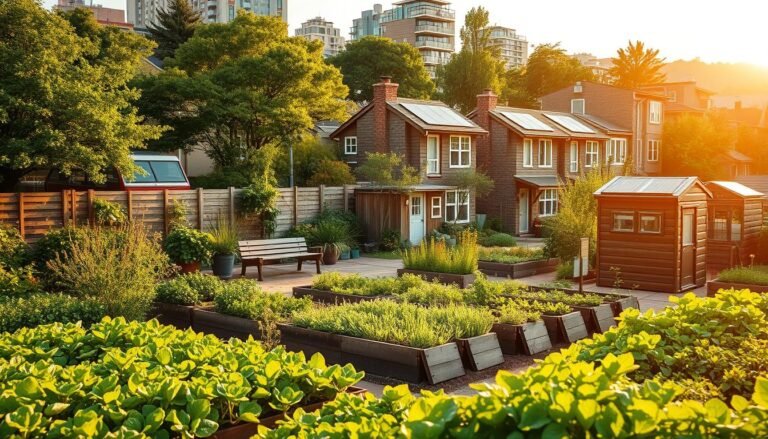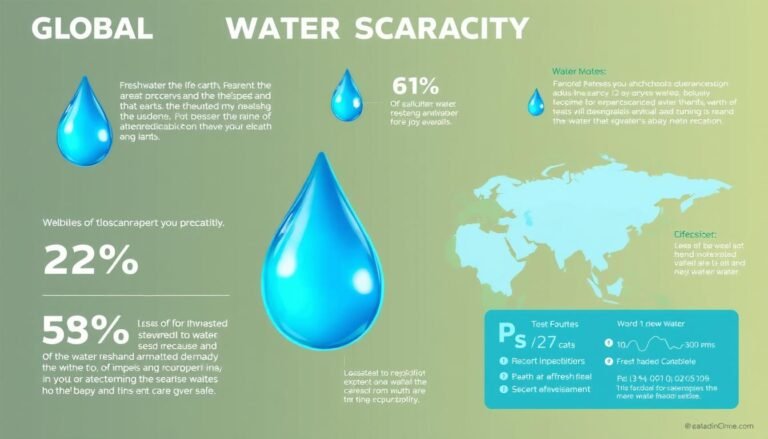Embracing a sustainable lifestyle is a journey that starts with small, achievable changes. As a beginner, it’s essential to understand the impact of daily choices on the environment and identify areas where changes can be made.
By making simple changes to daily habits, individuals can significantly reduce their environmental footprint. Sources like One Tree Planted and ISB Global provide valuable insights into the importance of reducing waste and offer practical tips for embracing a low-waste lifestyle.
Key Takeaways
- Start with small, achievable changes to daily habits
- Understand the impact of daily choices on the environment
- Identify areas where changes can be made to reduce waste
- Explore practical tips for embracing a sustainable lifestyle
- Make a positive impact on the environment with simple changes
Understanding the Low-Waste Movement
The low-waste movement is gaining momentum globally, and Australia is no exception. As people become more aware of their environmental impact, they’re seeking ways to reduce their waste. But what does “low-waste” actually entail?
What Does “Low-Waste” Actually Mean?
Low-waste living is about making conscious choices to minimize waste and reduce environmental harm. It’s a lifestyle that encourages individuals to be mindful of their consumption patterns and to adopt habits that generate less waste.
Low-Waste vs. Zero-Waste: Setting Realistic Expectations
While zero-waste is the ultimate goal for some, it’s not always achievable. Low-waste living is about progress, not perfection. According to ISB Global, the zero-waste movement is about reducing waste to a minimal level, but it’s not always possible to achieve zero waste. Understanding this distinction helps set realistic expectations for those starting their low-waste journey.
The Growing Movement in Australia
Australia is witnessing a significant shift towards low-waste living. Communities are coming together to reduce their environmental footprint, and individuals are making changes in their daily lives to live more sustainably. This growing movement is a positive step towards a more environmentally conscious future.
Embracing a low-waste lifestyle is a journey, and every small change counts. By understanding the principles of low-waste living, Australians can make a significant impact on reducing waste and promoting sustainability.
Why Adopt a Low-Waste Lifestyle for Beginners
Adopting a low-waste lifestyle is a simple yet effective way to contribute to a more sustainable future. By making a few simple changes to daily habits, individuals can significantly reduce their environmental footprint.
Environmental Benefits for Australia’s Unique Ecosystems
Australia’s diverse ecosystems, from the Great Barrier Reef to the Outback, are vulnerable to the impacts of pollution and waste. By adopting a low-waste lifestyle, individuals can help protect these ecosystems and preserve natural resources. Reducing waste can also help mitigate the effects of climate change, which is crucial for Australia’s environment.
Personal Health Advantages
A low-waste lifestyle often goes hand-in-hand with healthier choices. For example, reducing food waste by planning meals and using up leftovers can lead to a healthier diet. Additionally, avoiding products with harsh chemicals can improve personal health and well-being. By choosing products with minimal packaging, individuals can also reduce their exposure to potential toxins.
Economic Savings Over Time
While some eco-friendly products may have a higher upfront cost, adopting a low-waste lifestyle can lead to significant economic savings over time. For instance, reducing energy consumption and using reusable products can lower household expenses. Buying in bulk and avoiding single-use products can also save money, making it a financially savvy choice.
By understanding the benefits of a low-waste lifestyle, individuals can make informed choices that contribute to a more sustainable future while also improving their personal health and economic well-being.
Assessing Your Current Waste Output
A waste audit is a practical way to understand your household’s waste generation patterns. By conducting a thorough examination of your waste, you can identify areas where you can make significant reductions.
Conducting a Home Waste Audit
To start, gather your waste and recyclables for a week. Sort items into categories like paper, plastic, glass, and food waste. This hands-on approach will give you a clear picture of your consumption habits. For instance, you might be surprised at how much food waste you generate or how many plastic bags you use.
Identifying Your Biggest Waste Sources
Once you’ve audited your waste, analyze the data to pinpoint your biggest waste sources. Are you generating more waste from food packaging or single-use plastics? Identifying these sources is crucial for developing targeted strategies to reduce your waste. Make a list of the top contributors to your waste stream.
Setting Achievable Reduction Goals
With your waste sources identified, set realistic goals for reduction. For example, you might aim to reduce your plastic waste by 50% in the next three months. Start with small, manageable changes that you can sustain over time. Some effective strategies include:
- Reducing your use of single-use plastics
- Implementing a recycling program
- Composting food waste
By following these steps, you’ll be well on your way to a more sustainable, low-waste lifestyle.
Starting Your Low-Waste Journey: The Mindset Shift
To truly embrace a low-waste lifestyle, one must first undergo a significant mindset shift, prioritizing progress over perfection. This change in perspective is crucial for making sustainable choices that support a low-waste lifestyle.

Embracing Imperfection and Progress
A key aspect of this mindset shift is embracing imperfection and focusing on progress. It’s about understanding that sustainable living is a journey, not a destination. By acknowledging that it’s okay to make mistakes and that every small change counts, individuals can foster a more positive and resilient approach to reducing their waste.
The Power of Small, Consistent Changes
Making small, consistent changes is a powerful strategy for sustaining a low-waste lifestyle. These changes might include simple actions like carrying a reusable bag or choosing products with minimal packaging. By incorporating these habits into daily life, individuals can make a significant impact over time.
Developing a “Need vs. Want” Filter
Another crucial aspect of the low-waste mindset is developing a “need vs. want” filter. This involves being more mindful of consumption habits and distinguishing between essential purchases and impulse buys. By adopting this filter, individuals can reduce unnecessary waste and make more low-waste tips a part of their daily routine.
Kitchen Transformations: Reducing Food Waste
The kitchen is often the heart of the home, and making it a hub for sustainability begins with reducing food waste. By implementing a few simple strategies, you can significantly decrease the amount of waste generated in your kitchen.
Meal Planning Strategies for Australian Seasonal Produce
Meal planning is a powerful tool in reducing food waste. By planning your meals around Australian seasonal produce, you can ensure that you use up all the ingredients you buy. This approach not only reduces waste but also supports local farmers and ensures you’re getting the freshest produce.
- Check what’s in season and plan meals accordingly
- Make a shopping list to avoid buying too much
- Cook meals that use similar ingredients to reduce waste
Food Storage Solutions to Extend Freshness
Proper food storage is crucial in extending the freshness of your produce. Using the right storage methods can prevent spoilage and keep your food fresh for longer.
| Produce | Storage Method | Expected Freshness Duration |
|---|---|---|
| Leafy Greens | Store in a sealed container with a paper towel | Up to 7 days |
| Berries | Keep in a covered container in the refrigerator | Up to 5 days |
| Root Vegetables | Store in a cool, dark place | Up to 2 weeks |
Composting Basics for Different Living Situations
Composting is a great way to turn food scraps into nutrient-rich soil. Whether you live in a small apartment or a large house, there are composting solutions available.
For small spaces, consider using a bokashi bin or a worm composter. For larger spaces, an outdoor compost heap or a compost tumbler can be effective.
By implementing these strategies, you can significantly reduce food waste in your kitchen, contributing to a more sustainable lifestyle.
Sustainable Shopping Habits
Embracing sustainable shopping habits can significantly impact our planet’s health. By making a few simple changes to our daily shopping routine, we can reduce waste, support local communities, and promote environmentally friendly practices.
Bringing Your Own Bags, Containers, and Bottles
One of the easiest ways to start sustainable shopping is by bringing your own bags, containers, and bottles. Reusable bags are a great starting point, reducing the need for single-use plastic bags. Similarly, using reusable containers for buying in bulk and carrying coffee or takeaway can significantly cut down on waste.
Finding Bulk Food Stores and Farmers Markets in Australia
Shopping at bulk food stores and farmers markets is another effective way to reduce packaging waste. Australia has numerous bulk food stores and vibrant farmers markets where you can buy fresh produce, grains, and other essentials without the excess packaging. These markets also support local farmers and producers, contributing to the local economy.
Reading Labels and Making Informed Choices
When shopping, it’s essential to read labels and make informed choices. Look for products with minimal packaging, those that are made from recycled materials, or products that are sustainably sourced. Being mindful of the products we buy and their environmental impact is a crucial step towards a more sustainable lifestyle.
By incorporating these low-waste tips into our shopping habits, we not only reduce our environmental footprint but also promote a healthier lifestyle for ourselves and our communities.
Bathroom Swaps for Eco-Friendly Living
Transforming your bathroom into an eco-friendly oasis starts with simple swaps. By making a few mindful changes, you can significantly reduce your environmental footprint and contribute to a more sustainable future.
Plastic-Free Toiletries Available in Australia
One of the easiest ways to make your bathroom more eco-friendly is by switching to plastic-free toiletries. Many Australian brands now offer sustainable alternatives to traditional toiletries, such as bamboo toothbrushes, shampoo bars, and soap made from natural ingredients. For example, Unilever’s Love Beauty and Planet range offers eco-friendly options that are both effective and gentle on the skin.
Water Conservation Tips for Drought-Prone Areas
Water conservation is crucial, especially in drought-prone areas. Simple actions like turning off the tap while brushing your teeth or taking shorter showers can make a big difference. Installing low-flow showerheads and dual-flush toilets are also effective ways to reduce water usage. As the Australian Government suggests, these small changes can significantly impact water conservation efforts.
“Every small change counts when it comes to water conservation. By adopting these simple habits, we can make a significant difference in preserving this precious resource.”
Australian-Made Sustainable Products Worth Trying
Australia is home to many innovative brands offering sustainable bathroom products. From Koala Klean natural cleaning products to FaHnen eco-friendly personal care items, there’s a growing market for sustainable choices. When shopping, look for products with minimal packaging and made from natural, biodegradable ingredients to reduce your environmental impact.
By incorporating these eco-friendly bathroom swaps into your daily routine, you’ll be taking significant steps towards a more sustainable lifestyle. Every change, no matter how small, contributes to a larger positive impact on the environment.
Cleaning Your Home the Low-Waste Way
Low-waste cleaning is easier than you think, and it’s a great way to start living more sustainably. By making a few simple changes to your cleaning routine, you can significantly reduce your environmental footprint.
DIY Cleaning Solutions Using Pantry Staples
One of the easiest ways to start low-waste cleaning is by making your own cleaning solutions using pantry staples. Ingredients like baking soda, vinegar, and lemon juice are not only effective but also environmentally friendly. For example, a simple mixture of baking soda and water can be used to clean surfaces, while vinegar is great for disinfecting.
Here are some simple DIY cleaning recipes:
- All-purpose cleaner: Mix 1 cup water, 1/2 cup white vinegar, and 1 tablespoon baking soda.
- Glass cleaner: Mix 1 cup water, 1 tablespoon white vinegar, and 1 tablespoon freshly squeezed lemon juice.
Reusable Cleaning Tools That Last
Switching to reusable cleaning tools is another effective way to reduce waste. Microfiber cloths, for instance, can be used multiple times and are effective at picking up dirt and dust. Additionally, using a mop with a washable head or a scrubber made from natural fibers can significantly cut down on disposable cleaning product waste.

Avoiding Harmful Chemicals in Australian Products
When shopping for cleaning products, it’s essential to read labels carefully and avoid products containing harmful chemicals. Look for products that are labeled as eco-friendly or non-toxic. Supporting Australian brands that prioritize sustainability can also make a positive impact.
“The most effective cleaning products are often the simplest ones, made from natural ingredients that are gentle on surfaces and the environment.”
By adopting these low-waste cleaning practices, you not only contribute to a healthier environment but also create a safer home for your family. Start your low-waste cleaning journey today and make a positive impact on the planet.
Wardrobe and Fashion Choices
A more conscious approach to fashion can significantly reduce waste and support a healthier environment. The fashion industry is one of the largest polluters globally, making it crucial for consumers to adopt sustainable practices.
Building a Climate-Appropriate Capsule Wardrobe
Creating a capsule wardrobe tailored to Australia’s climate is an effective way to reduce fashion waste. This involves selecting a limited number of versatile, high-quality pieces that can be mixed and matched. For Australia’s varied climate, consider including:
- Lightweight, breathable fabrics for warmer months
- Versatile layers for cooler seasons
- Comfortable, durable footwear suitable for different occasions
By focusing on essential items, you can reduce decision fatigue and create a more streamlined, sustainable wardrobe.
Second-Hand Shopping and Clothing Exchanges in Australia
Second-hand shopping is a growing trend in Australia, offering a sustainable alternative to fast fashion. You can find great deals on gently used clothing at thrift stores, online marketplaces, and local clothing swaps. Not only does this reduce waste, but it also supports local communities.
| Benefits | Second-Hand Shopping | Clothing Exchanges |
|---|---|---|
| Environmental Impact | Reduces landfill waste | Refreshes wardrobe without buying new |
| Economic Benefits | Saves money | Free or low-cost wardrobe refresh |
| Social Benefits | Supports local charities | Encourages community engagement |
Caring for Clothes to Extend Their Life
Proper care of your clothes can significantly extend their lifespan. Simple practices like washing clothes in cold water, avoiding over-drying, and storing items properly can make a big difference. For delicate or special-care items, consider hand washing or professional cleaning.
By adopting these sustainable fashion practices, Australians can contribute to a more environmentally friendly fashion industry. Every small change counts, from building a capsule wardrobe to caring for your clothes.
Reducing Paper and Plastic Waste
As we strive to minimize our environmental footprint, reducing paper and plastic waste becomes increasingly important. This involves adopting simple yet effective changes in our daily lives.
Digital Alternatives for Bills and Documents
Switching to digital bills and documents is a straightforward way to reduce paper waste. Many service providers now offer digital alternatives, making it easier to manage your finances and paperwork online.
Reusable Alternatives to Common Single-Use Items
Using reusable bags, containers, and water bottles can significantly cut down on plastic waste. For instance, keeping reusable bags handy for grocery shopping can prevent the need for single-use plastic bags.
Navigating Australia’s Plastic Bag Bans
Australia has implemented plastic bag bans in various states to reduce plastic waste. Understanding and complying with these bans is crucial for minimizing our plastic footprint.
By embracing digital alternatives, reusable products, and adhering to plastic bag bans, Australians can make a significant impact on reducing paper and plastic waste, contributing to a more sustainable future.
| Action | Impact |
|---|---|
| Switching to digital bills | Reduces paper waste |
| Using reusable bags and containers | Cuts down on plastic waste |
| Complying with plastic bag bans | Minimizes plastic pollution |
Low-Waste Lifestyle for Beginners: Creating Sustainable Habits
A low-waste lifestyle isn’t just about making changes; it’s about creating lasting habits. To achieve this, beginners can employ several strategies that make the transition smoother and more sustainable.
The 30-Day Challenge Method
One effective way to adopt new habits is through the 30-day challenge method. This involves committing to a new habit for 30 days straight, making it easier to stick to it in the long run. For example, you could start by bringing your own reusable bag when shopping.
Tracking Your Progress and Waste Reduction
Tracking your progress is crucial for maintaining motivation. Keep a journal or use an app to monitor your waste reduction efforts. This could involve recording the amount of waste you produce each day or noting the successful implementation of new habits. You can find more tips on reducing waste on the One Tree Planted website.
Celebrating Small Wins Along the Way
Celebrating small victories is essential for staying motivated on your low-waste journey. Whether it’s a week of zero food waste or a month of using public transport, acknowledging these achievements can boost your morale.
| Habit | 30-Day Challenge | Long-Term Impact |
|---|---|---|
| Bringing reusable bags | Reduced plastic use | Significant decrease in plastic waste |
| Using public transport | Lower carbon emissions | Improved air quality |
| Composting | Reduced landfill waste | Creation of nutrient-rich soil |
By adopting the 30-day challenge method, tracking your progress, and celebrating small wins, you can create sustainable habits that support your low-waste lifestyle. These habits not only contribute to a more environmentally friendly way of living but also foster a sense of community and personal achievement.
Navigating Social Situations and Family Resistance
As you start your low-waste journey, you may encounter resistance or skepticism from family and friends. This can be challenging, but there are ways to navigate these situations effectively.
Communicating Your Choices Without Preaching
When discussing your low-waste lifestyle with others, it’s essential to communicate your choices clearly and without being judgmental. Avoid making others feel guilty or inadequate about their own waste production. Instead, share your personal reasons for adopting a low-waste lifestyle and the benefits you’ve experienced. This approach can help others understand your perspective without feeling lectured.
Handling Gifts, Holidays, and Special Occasions
Social gatherings and special occasions often involve gift-giving, which can be a challenge for those trying to reduce waste. You can graciously suggest alternative gifts, such as experiences or consumables, or express your preference for second-hand or sustainable items. Creating a wishlist that includes eco-friendly options can also guide your loved ones.
Finding Like-Minded Communities in Your Area
Connecting with others who share your commitment to a low-waste lifestyle can be incredibly supportive. Look for local groups or online forums where you can exchange ideas, share tips, and participate in community activities. This can help you stay motivated and inspired on your journey.
| Tips for Navigating Social Situations | Benefits |
|---|---|
| Communicate your choices clearly | Builds understanding and respect |
| Suggest eco-friendly gifts | Reduces waste and promotes sustainability |
| Join like-minded communities | Provides support and motivation |
Low-Waste on a Budget
Adopting a low-waste lifestyle can be budget-friendly, focusing on practical swaps and community resources. By making a few simple changes, individuals can significantly reduce their waste without breaking the bank.
Affordable Swaps That Save Money
One of the easiest ways to start living a low-waste lifestyle is by making affordable swaps. For instance, switching from disposable bags to reusable ones can save money in the long run. Similarly, opting for refillable water bottles instead of buying bottled water can be both cost-effective and environmentally friendly.
- Replace paper towels with cloth towels
- Use rags or cloth napkins instead of paper products
- Choose products with minimal or biodegradable packaging
When to Invest vs. When to Make Do
While some eco-friendly products may seem more expensive upfront, they can offer long-term savings. It’s essential to differentiate between when to invest in more sustainable options and when to make do with what you have. For example, investing in a good-quality reusable coffee cup might seem like an initial expense, but it can save you money over time if you regularly buy coffee.
Finding Community Resources and Share Programs
Utilizing community resources and share programs is another effective way to live a low-waste lifestyle on a budget. Many communities have tool-sharing libraries, clothing swaps, or local buy-nothing groups. These resources not only reduce waste but also foster a sense of community.
| Resource | Description | Benefits |
|---|---|---|
| Tool-sharing libraries | Access to various tools without the need for individual ownership | Reduces waste, saves money |
| Clothing swaps | Exchange gently used clothing with others | Updates wardrobe without buying new, reduces textile waste |
| Buy-nothing groups | Platforms where people give away items they no longer need | Reduces waste, provides free items to those in need |
By embracing affordable swaps, being mindful of when to invest, and leveraging community resources, individuals can adopt a low-waste lifestyle without straining their budget. It’s about making conscious choices that benefit both the environment and your wallet.
Uniquely Australian Challenges and Solutions
The Australian environment, with its extreme weather events and rich indigenous heritage, demands special consideration for sustainable living. As the country faces increasingly severe weather conditions, from droughts to bushfires, adopting a low-waste lifestyle can significantly mitigate its environmental footprint.
Dealing with Extreme Weather Events Sustainably
Extreme weather events in Australia necessitate preparedness and sustainable practices. This includes creating emergency kits with reusable items, having a plan for sustainable food storage, and ensuring that homes are prepared for extreme weather conditions. By focusing on zero waste living, Australians can reduce their vulnerability to such events.
Navigating Local Council Recycling Programs
Understanding and utilizing local council recycling programs is crucial for effective waste management. Australians can start by familiarizing themselves with their local council’s guidelines on recycling, composting, and waste reduction. This knowledge can significantly impact the amount of waste sent to landfills.
Indigenous Wisdom on Sustainable Living Practices
Australia’s indigenous communities have long practiced sustainable living in harmony with the environment. By embracing indigenous wisdom, such as living with the land and reducing waste, modern Australians can learn valuable lessons for their own low-waste journeys. This includes adopting practices like using native plants for gardening and respecting the land’s natural cycles.
By addressing Australian challenges with innovative solutions, such as enhancing recycling programs and embracing indigenous knowledge, individuals can contribute to a more sustainable future. This holistic approach not only aids in zero waste living but also fosters resilience against extreme weather events.
When Things Get Tough: Overcoming Common Obstacles
Maintaining a low-waste lifestyle can be tough, but with the right strategies, you can overcome common hurdles. As you continue on your journey, it’s essential to be aware of the potential obstacles and know how to navigate them.
Managing Eco-Anxiety and Avoiding Burnout
Eco-anxiety is a growing concern for many individuals committed to sustainable living. To manage this anxiety, it’s crucial to focus on what you can control and celebrate your achievements. Prioritizing self-care and taking breaks when needed can help prevent burnout.
| Strategies | Benefits |
|---|---|
| Mindfulness and meditation | Reduces stress and anxiety |
| Connecting with nature | Improves mental well-being |
| Setting realistic goals | Enhances motivation and progress |
Adjusting Your Approach During Life Changes
Life changes, such as moving homes or having children, can impact your low-waste practices. Being flexible and adapting your approach to suit new circumstances is vital. Reassessing your priorities and finding new ways to maintain your commitment to low-waste living can help you stay on track.
Getting Back on Track After Setbacks
Setbacks are inevitable, but they don’t have to derail your entire journey. By acknowledging the setback and recommitting to your goals
By understanding how to manage eco-anxiety, adjust to life changes, and recover from setbacks, you can maintain a sustainable low-waste lifestyle. Remember, every small step counts, and being kind to yourself throughout the journey is essential.
Conclusion: Your Ongoing Low-Waste Journey
Embracing a low-waste lifestyle is a continuous process that requires ongoing commitment and a willingness to learn and adapt. As you’ve discovered throughout this article, making small changes can have a significant impact on the environment. By adopting sustainable habits, you’re not only reducing your waste output but also contributing to a broader cultural shift towards sustainability.
As you continue on your low-waste journey, remember that every step counts, and it’s okay to take it one step at a time. Focus on making progress, not perfection. Celebrate your successes, whether it’s reducing your plastic use or finding creative ways to repurpose old items. By maintaining an ongoing commitment to sustainability, you’ll be able to make a lasting impact on the environment.
For beginner sustainability enthusiasts, the key is to start small and be consistent. As you navigate the ups and downs of a low-waste lifestyle, you’ll become more confident in your ability to make sustainable choices. By working together, we can create a more sustainable future for Australia and beyond.





